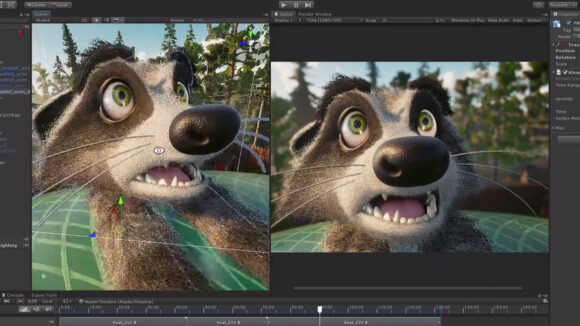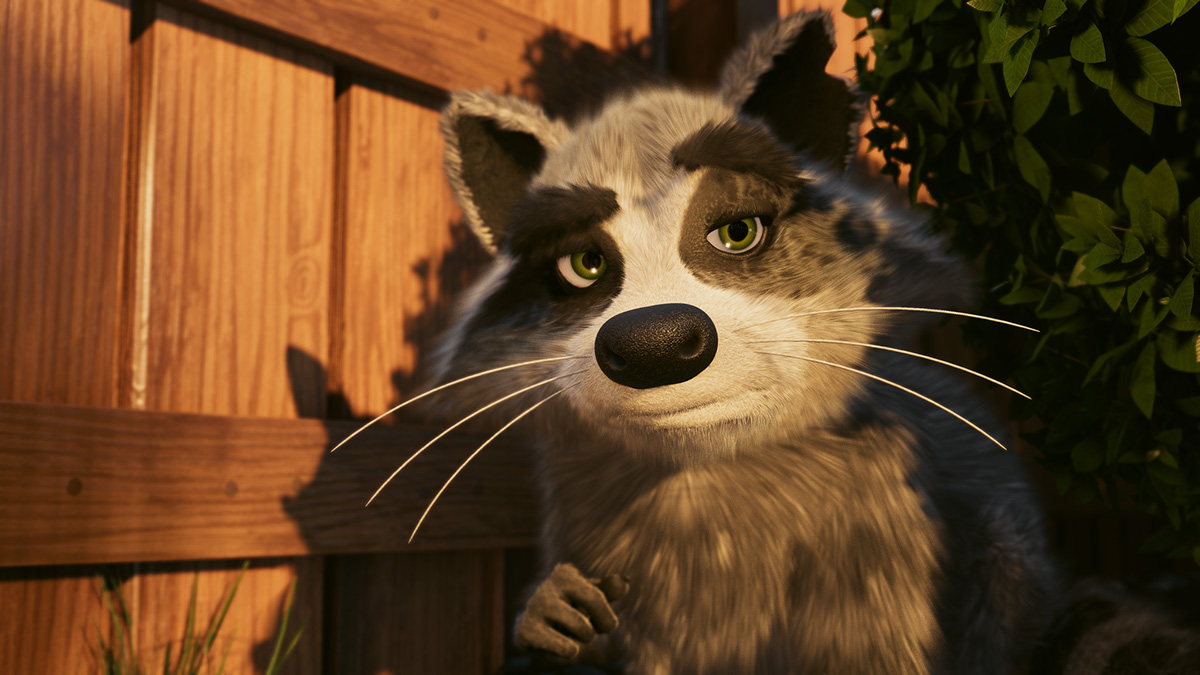

You Can Use The Actual Assets and Workflow From This Real-Time Unity Film in Your Own Projects – Annecy
The possibilities of real-time rendering and game engines in animation production seem to be more and more apparent every week. Now Unity, one of the major game engine makers, has released a new animated short, Sherman, to showcase its latest real-time tech.
The short features a hapless raccoon tormented by a backyard sprinkler while a small bird (called Sherman) looks to gain a quick advantage. It was made by the Unity team as a demonstration of the software’s linear animation abilities, in particular highlighting the real-time fur shader, high-definition render pipeline, and results from Unity’s Visual Effect Graph.
Like some previous Unity projects, the full Sherman Unity project and source files, including models and animation, will be available to download, including starter shaders and templates to enable users to create their own films.
“Sherman originated right as we finished our Disney co-production Baymax Dreams,” Isabelle Riva, the head of media entertainment innovation group at Unity Technologies, told Cartoon Brew. “We had learned so much from that experience that we wanted to apply that to a template project that we would be able to share with the community.”

While Sherman was being made, Unity continued to develop several new tools inside the software. This included further support for the Alembic file and interchange format (a staple in most animation and vfx pipelines), improvements to the engine’s Visual Effect Graph, a new filmic motion blur shader, an eye shader incorporating sub-surface scattering, and, significantly, an improved fur shader that works for hair and feathers.
For those who are used to a more traditional animation pipeline, such as one involving Maya and an offline renderer, the Sherman workflow still involved an initial modeling and animation approach. But the idea with the short was to show how much more can now be done inside Unity in terms of blocking, lighting, effects, and of course in terms of rendering in real-time.
“When you’re blocking your film, you can use a feature in Unity called Pro Builder to do a quick 3d representation of your environment,” said Riva. “Or you can load in models or proxies from Maya or 3ds Max. That is expressed in Unity and you’re able to then populate your 3d environment in Unity. The same goes for models – we have a universal Unity rig you can apply to models so that you’re able to load up your character from your animation software, add your textures from elsewhere, and then you’re able to apply with the Unity universal rig basic walk cycles, run cycles, or move the character around within that 3d space.”
In terms of layout, Unity can also be used, says Riva, to position ‘smart cameras.’ “You’re able to point and click a camera that gets attached to a character and hold that frame or that composition even through changes in animation or layout. It never breaks, even as you iterate and move things around in the space. You can keep that camera. And we have rigs and behaviors you can drag and drop onto that smart camera. The suite of features – called Cinemachine – lets you lay that down as a track in our sequencer so you can toggle between different cameras and views and decide how you want to shoot the character.”

The idea is that this workflow is intended to replicate live-action cinematography and editing workflow, including the use of color correction, lens effects, and then camera movement with rigs, dollies, and other layout tools. Added to this are lookdev and lighting tools that deal with sun direction, spotlights, and global illumination. Remember, too, this is all for rendering in real-time, so the artist gets to see changes made on the fly.
“You have all these departments all in one workflow, in one software,” explained Riva. “Collaboration happens in a way that that usual silo’d process is really broken down. Everybody is working in parallel and then suddenly the director has so much more confidence when making layout decisions.”
At Annecy this week, Unity is showcasing Sherman’s use of these new layout, lighting, rendering, and lookdev tools. In addition, other films at the festival which have used Unity will also be ones the company will be discussing, including The Relative Worlds by Yuhei Sakuragi and Japan’s Craftar Studios. “They used a toon shader which flattens the image that was developed in Unity,” said Riva. “They rendered half of the film in Unity mixed with 3ds Max and they also did all their crowd shots in Unity. We’re very excited that as a real-time project this was selected by the festival.”
Meanwhile, in relation to Sherman, Unity has packaged up the film’s assets and workflow tools so that users of Unity version 2018.4 can begin working on their own project straight away. Head to this page to download the project.

.png)